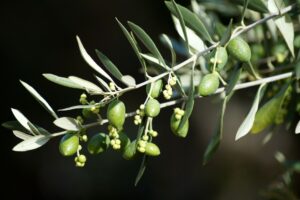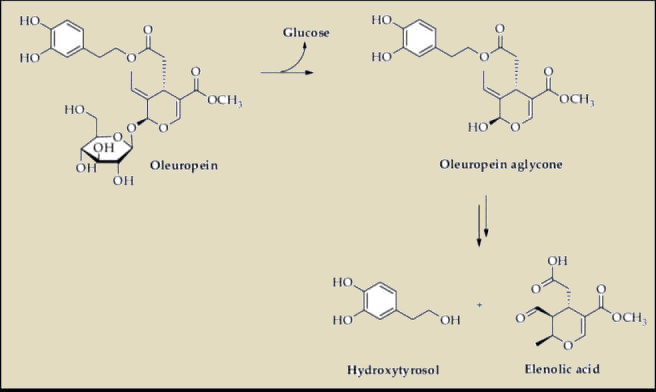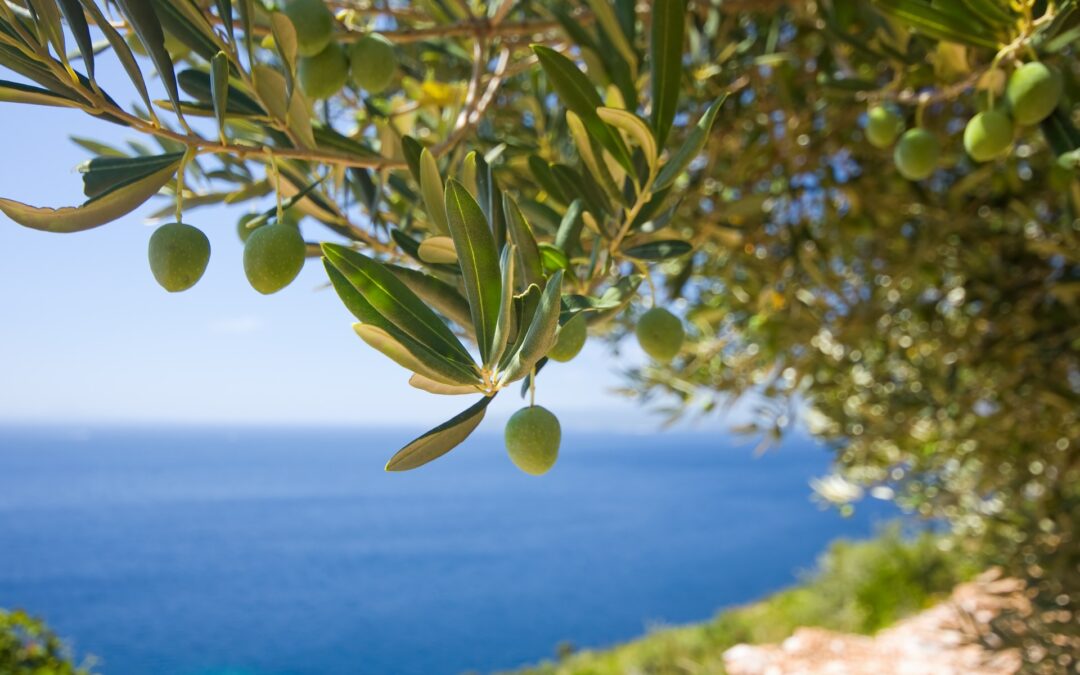There’s a growing interest in the study of the pharmacological properties of the constituents of olive leaves extract which could be a valuable natural aid for cardiovascular disease. Here here we report the research on Oleuropein benefits, since Oleuropein is the major active.
The olive tree (Olea europaea Linn., Fam. Oleaceae) is a prevalent plant species and one of the important cultivated crops in the Mediterranean region.
According to the European Pharmacopoeia, the most abundant substances in standardized dried leaf extracts are oleuropein, hydroxytyrosol, caffeic acid, tyrosol, luteolin-7-glucoside, apigenin-7-glucoside. Oleuropein which is one of the predominant biophenols in olive leaf extract. The total flavonoid and polyphenol content of olive leaves was determined as 2,058 mg GAE (gallic acid equivalent) per 100 g and 858 mg CTE (catechin equivalent) per 100 g, values similar to a red grape.
The phytotherapeutic tradition attributes to the olive leaves activities: hypotensive, diuretic, hypoglycemic. As indicated by Capasso, the leaf extract to be used is the one that contains 20% oleuropein.

Olive leaf extract: What is oleuropein
Oleuropein is a secoiridoide glycoside, as well as a chemotaxonomic marker of the olive tree. It consists of three structural subunits: hydroxytyrosol, elenolic acid and a glucose molecule. The enzymatic hydrolysis of oleuropein leads to the formation of oleuropein aglycone, which is further hydrolyzed into hydroxytyrosol and other non-glycosidic secoiridoids, such as elenolic acid. Another derivative of the metabolic breakdown of oleuropein is oleacein.
 Oleuropeina formula
Oleuropeina formula
Oleuropein extraction
To obtain the maximum extraction yield per kg of biomass, the olive leaves were extracted using a conventional technique (dynamic maceration) and an emerging technology, such as liquid extraction under pressure. Studies have been carried out on the factors influencing these processes: temperature, leaf moisture content, solvent concentration. Pressurized liquid extraction resulted in a more efficient oleuropein and luteolin-7-O-glucoside extraction than dynamic steeping. The operating conditions to maximize the recovery of phenolic compounds and flavonoids and the antioxidant capacity were determined at 190° C, leaf moisture content of 5% and aqueous concentration of ethanol of 80% (1).
Olive leaf extract: benefits and use
Hydroxytyrosol and oleuropein benefits on cardiovascular disease: oxidative stress and atherosclerosis
The pathogenesis of some common diseases, including those of the cardiovascular system, involves oxidative stress and inflammation of the tissues. Polyphenolic compounds in olive leaf extract, such as oleuropein, hydroxytyrosol or tyrosol, possess antioxidant, anti-inflammatory, anti-atherosclerotic and lipid-lowering effects on the myocardium, as demonstrated by various in vitro and in vivo studies (2). However of all the phenolic compounds in olive leaf extract, it is oleuropein that appears to be the promising molecule that could be used as a cardioprotective agent on the myocardium. Furthermore, vasodilatory and antiplatelet effects have also been assigned to the phenolic compound Oleuropein (3).
Heart and oxidative stress
Damage to the cardiovascular endothelium underlies cardiovascular disease. The endothelium is the direct target of all major risk factors for heart disease such as diabetes, hyperlipidemia, hyperglycemia, inflammation, aging and hypertension. Common to all of these pathophysiological conditions is the formation of reactive oxygen species (ROS) by endothelial mitochondria, which contributes to heart disease. Furthermore, oxidative stress within the ventricular myocytes can also be harmful to the heart; much of the contractile dysfunction and adverse myocardial remodeling, which has been observed in a wide range of cardiomyopathies, involves oxidative stress and endothelial nitric oxide decoupling, leading to decreased NO production and increased of the formation of ROS.
However, oxidative damage only occurs when oxidative stress levels exceed antioxidant defense capacity. As already demonstrated in patients with cardiovascular disease, the activity of endogenous antioxidant enzymes is reduced. Among these enzymes are superoxide dismutase, glutathionine peroxidase, catalase. It also reduces the activity of proteins such as albumin and metallothionein, which are known to exhibit antioxidant protection in the myocardium. Because the heart is one of the organs most susceptible to free radical-mediated oxidative stress, scavenging ROS can have various protective and beneficial effects on the heart.
Atherosclerosis
Atherosclerosis is the primary cause of cardiovascular disease and the underlying cause of over 50% of all deaths in Westernized societies. Cardiovascular disease is considered a consequence of atherogenesis and is the result of a complex network of interactions between different risk factors and endogenous cell signaling between arterial wall cells. It is well known that dyslipidemia, diabetes and platelet aggregation can lead to impaired endothelial function and the formation of atheroma. Atherosclerosis is a multifactorial disease in which inflammation and oxidative stress play an important role.
The oxidation of low-density lipoproteins (LDL) by ROS is an important factor in the formation of atheroma early in the evolution of the disease. Endothelial dysfunction is linked to the presence of oxidized LDL, which leads to a signal cascade including protein expression that induces atherogenesis and heart disease. Furthermore, platelet aggregation and degranulation appear to trigger thrombus formation and coronary artery occlusion, platelet activation factor (PAF) being a critical factor for platelet aggregation.
Oleuropein benefits on oxidative stress and atherosclerosis
Hydroxytyrosol and oleuropein exert a scavenging effect against HOCl, which acts as an initiating agent of LDL lipid peroxidation, and this effect causes a delay in the onset of atherosclerotic damage (3). Oleuropein also decreases the increase in inflammation markers, mediated by the metabolism of phospholipase C and arachidonic acid, and reduces high concentrations of hydrogen peroxide.
Carluccio et al. described the inhibition of endothelial activation, an early stage of atherogenesis, by oleuropein and hydroxytyrosol: these molecules reduce the lipopolysaccharide-stimulated expression of the vascular adhesion molecule VCAM-1 in human vascular endothelial cells by inhibiting its mRNA levels, thus decreasing the adhesion of monocytes to endothelial cells; they also antagonize platelet aggregation and the proliferation of smooth muscle cells (two further mechanisms involved in vascular damage).
In addition, regarding the oxidation of LDL, Jemai et al. showed that in rats fed a diet high in cholesterol, oleuropein and hydroxytyrosol were able to promote hypocholesterolemia by lowering plasma LDL levels and total cholesterol and to increase the levels of high density lipoprotein (HDL) and the activity of antioxidant enzymes that reduce the oxidation of LDL.
Oleuropein benefits on the metabolic syndrome
Searches of relevant literature published in English were conducted via PubMed and Science Direct. Based on published dietary intervention studies, there is compelling evidence to show that olive polyphenols reduce risk factors for metabolic syndrome, particularly by improving glycemic and blood pressure control and reducing lipoprotein low density (or LDL) oxidation (4).
Oleuropein and its constituents, hydroxytyrosol and elenolic acid (5):
- inhibit the formation of atherosclerotic plaque (cardioprotective action);
- reduce the inflammatory state that favors its accumulation, with an action that occurs both at the level of specific metabolic pathways and directly at the level of the genome (anti-inflammatory, antioxidant action);
- can contribute to an improvement in lipid metabolism with a reduction in the levels of triglycerides, total cholesterol and LDL cholesterol (hypoglycemic, hypocholesterolemic);
- favor the reduction of systolic pressure (hypotensive action) and inflammatory biomarkers (6).
Oleuropein benefits on hypertension
From a clinical point of view, the olive leaves can be used in the forms of arterial hypertension of a modest degree, where they cause hypotension through a mechanism of peripheral vasodilation: the olive leaf extract has good tolerability and does not cause a depressant action on the heart. It also has a coronary vasodilating action. The extract reduces blood viscosity and facilitates diuresis. The hypotensive effect appears 20-30 minutes after administration and gradually increases until the disappearance of the disorders due to the hypertensive state (7).
Oleuropein benefits on diabetes
Oleuropein possesses a series of biological activities including anti-lipid, anti-obesity, anti-diabetic, antioxidant, anti-atherogenic, anti-hypertensive, anti-inflammatory and hepatoprotective action (8). Thanks to these properties, oleuropein has aroused the growing interest of researchers in the management of diabetes and diabetes complications; the progress of this research is reported in a review (9), which among other things summarizes the molecular mechanisms involved in these beneficial effects of oleuropein. In particular:
- It promotes the improvement of diabetes, the mechanisms of which include the modulation of insulin secretion, the activation of the protein kinase activated by the hepatic AMP and the improvement of glucose tolerance and insulin resistance;
- it can also relieve the complications of diabetes, including diabetic nephropathy, cardiovascular complications of diabetes, diabetic retinopathy, poor wound healing, diabetic neuropathy, and diabetic testicular dysfunction. Oleuropein reverses cellular apoptosis, regenerates tissues, restores histological organization and reduces oxidative stress in the treatment of diabetes complications.
Oleuropein olive leaf extract: where to find the best ones
In our natural blood pressure lowering supplement, from Specchiasol research, there is oleuropein olive leaf extract tritated 20% in oleuropein; Hibiscus has been associated with it among the ingredients of the formulation. According to the European Pharmacopoeia, chalices and dried flower epicalics collected during the period of frutescence are used for Hibiscus. The drug must contain a maximum of 13.5% acid expressed as citric acid, in reference to the dried drug. According to numerous and accredited scientific researches, hibiscus also has the role of reducing pressure and is recommended in case of severe or moderate hypertension.
 ibisco
ibisco
Hibiscus extracts
Hibiscus extract, in in-vitro and in vivo studies, has shown:
- antibacterial, antioxidant, nephro and hepatoprotective, renal and diuretic effects,
- effects on lipid metabolism (anti-cholesterol), antidiabetic and antihypertensive effects, among others.
This could be linked to strong antioxidant activities, inhibition of α-glucosidase and α-amylase, inhibition of angiotensin converting enzymes (ACE) and direct vasorelaxant or modulation of calcium channels. Moreover, Phenolic acids (particularly protocatechuic acid), organic acid (hydroxycitric acid and hibiscus acid) and anthocyanins (delphinidin-3-sambubioside and cyanidin-3-sambubioside) are likely to contribute to the reported effects (10, 11). The anthocyanins of the hibiscus also have an angioprotective action.
If you want to combine the supplement with oleuropein (you can find it HERE) with one of our bud extractives, look at the olive bud extract.
Oleuropein and cosmetics: look at the Domus Olea Toscana eco-friendly cosmeceutical line
For any clarification or for more information Contact us.
Follow us on our Facebook and Instagram channels
ALL RIGHT ARE RESERVED, THIS TEXT IS NOT REPRODUCIBLE WITHOUT EXPRESS AUTHORIZATION OF ERBORISTERIA COMO.
The information contained in this site is presented for informational purposes only, in no case can they constitute the formulation of a diagnosis or the prescription of a treatment, and do not intend and must not in any way replace the direct doctor-patient relationship or the specialist visit. . It is recommended that you always seek the advice of your doctor and / or specialists regarding any indication reported.
Bibliography
- Estrazione di oleuropeina e luteolin-7-O-glucoside dalle foglie di olivo: ottimizzazione della tecnica e delle condizioni operative
- Effects of the olive tree leaf constituents on myocardial oxidative damage and atherosclerosis
- Beneficial effects of the olive oil phenolic components oleuropein and hydroxytyrosol: focus on protection against cardiovascular and metabolic diseases
- Olive Polyphenols and the Metabolic Syndrome
- Polyphenols benefits of olive leaf (Olea europaea L) to human health
- Effetto dell’estratto di foglie di olivo sul profilo cardiometabolico tra gli adulti con preipertensione e ipertensione: una revisione sistematica e una meta-analisi
- Dizionario di fitoterapia e piante medicinali, E. Campanini
- Oleuropein: A natural antioxidant molecule in the treatment of metabolic syndrome
- Efficacy and Mechanisms of Oleuropein in Mitigating Diabetes and Diabetes Complications
- Hibiscus sabdariffa L. – a phytochemical and pharmacological review
- Hibiscus sabdariffa extract lowers blood pressure and improves endothelial function

